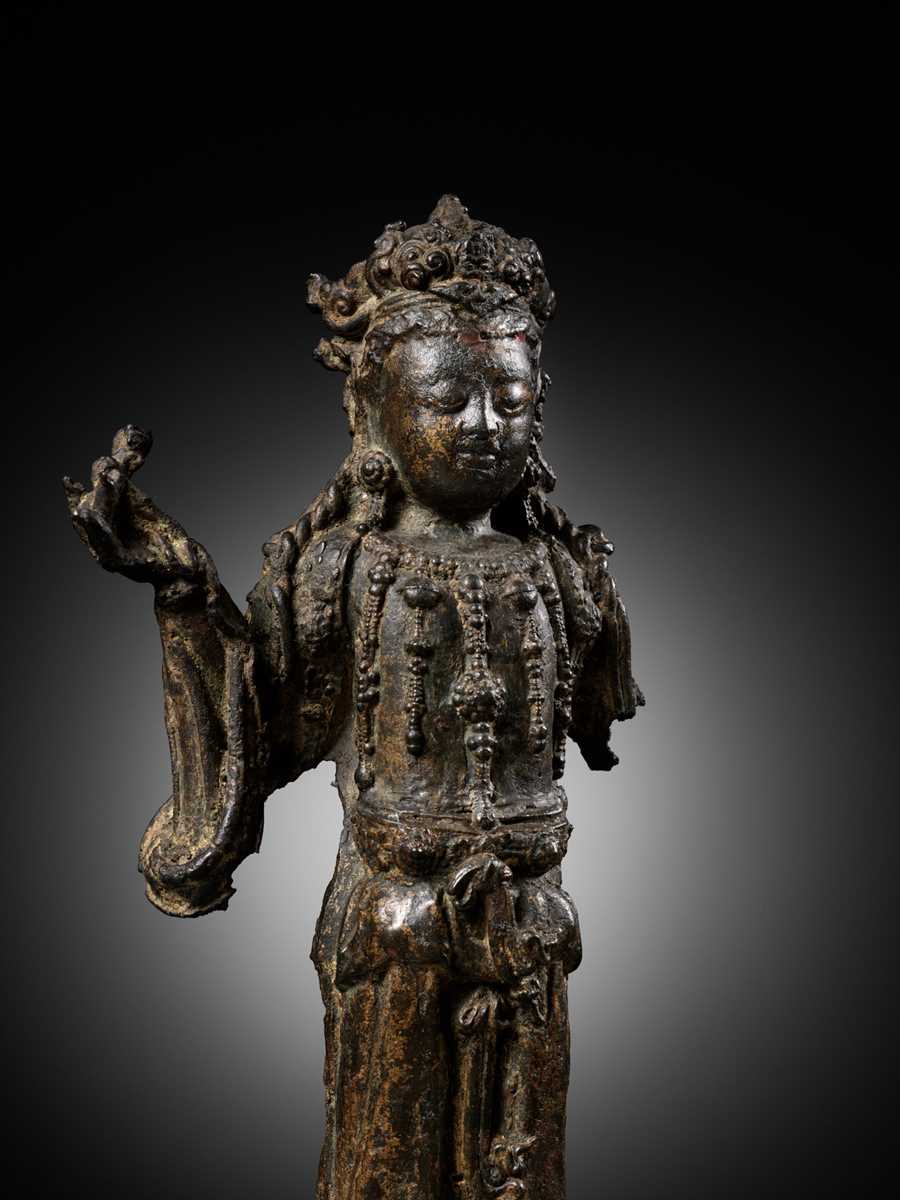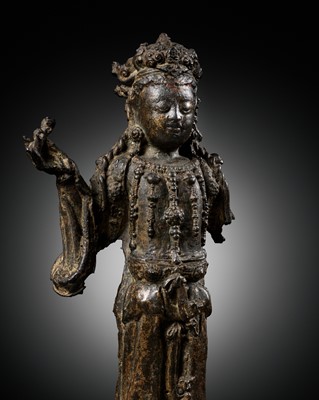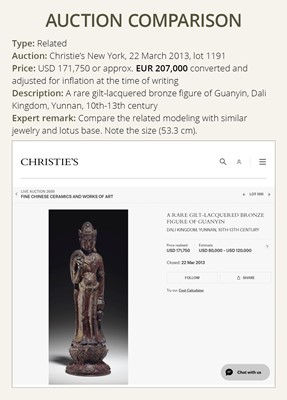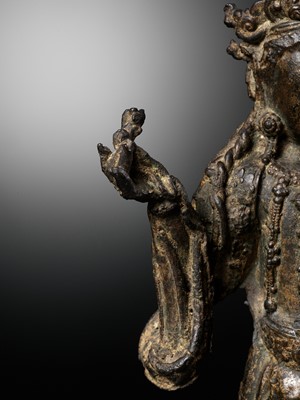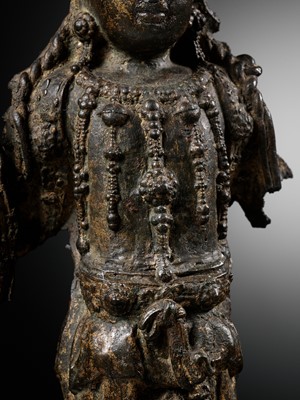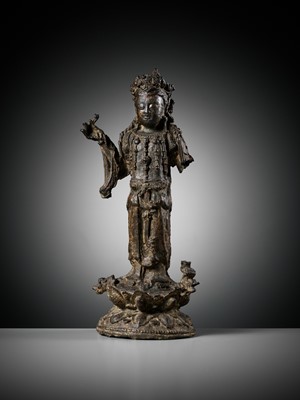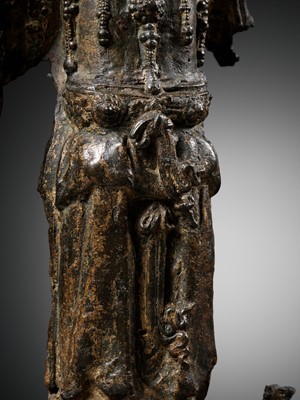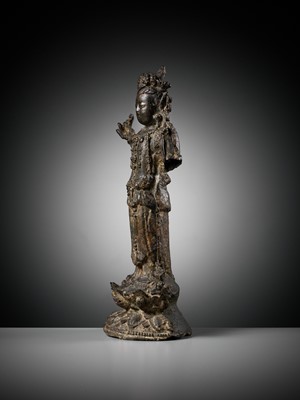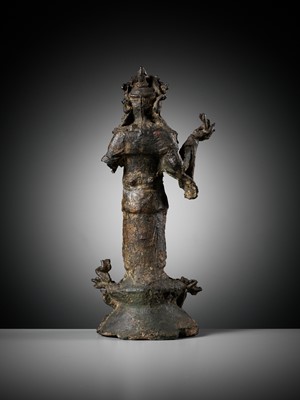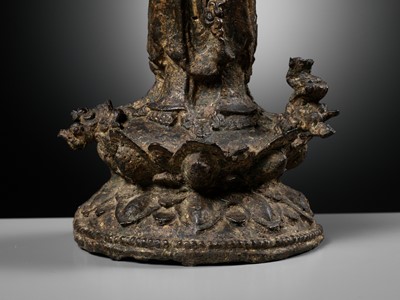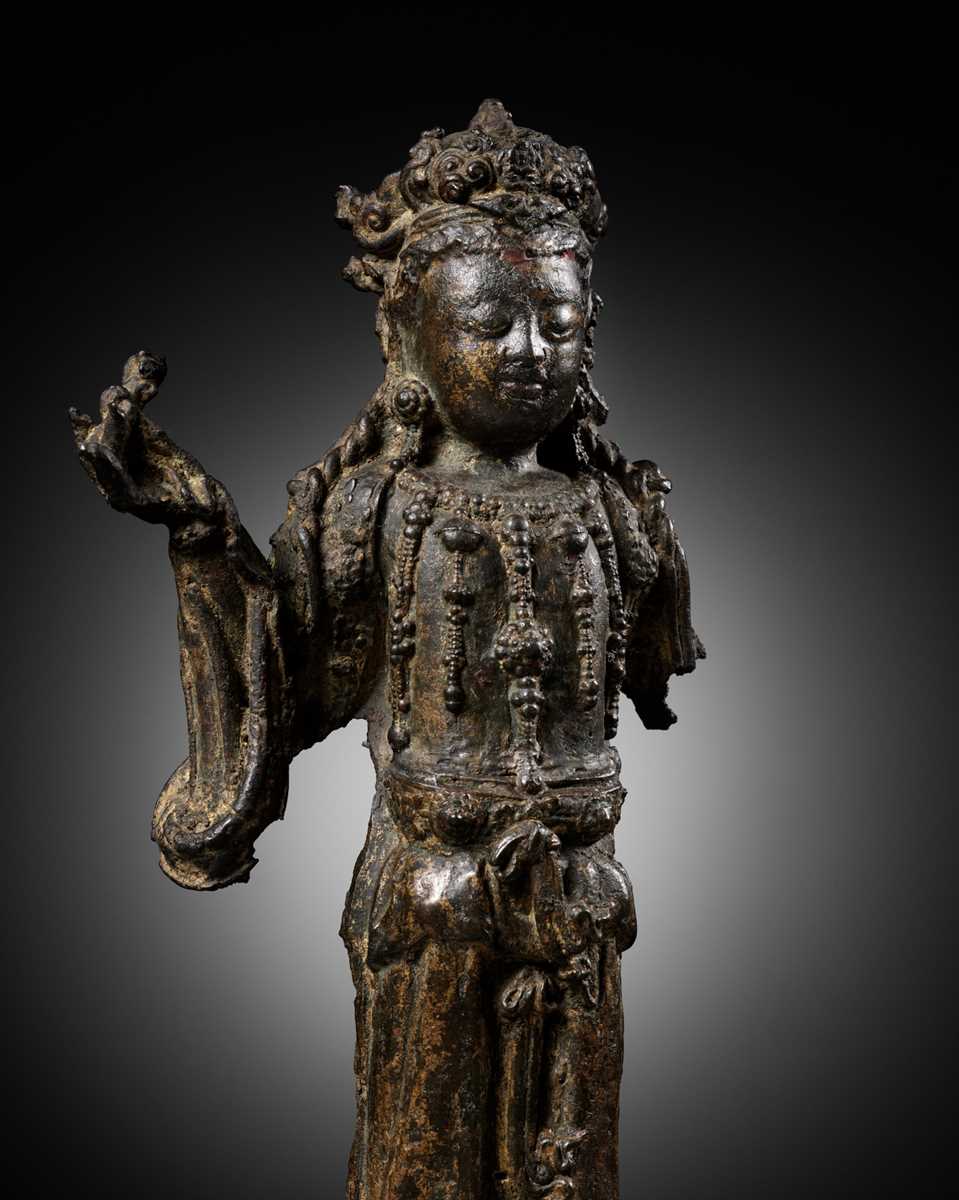13th Dec, 2023 13:00
Fine Asian Art Holiday Sale
67
A BRONZE FIGURE OF THE WILLOW-BRANCH GUANYIN, BHAISAJYARAJA AVALOKITESHVARA, DALI KINGDOM
大理國楊柳觀音銅像
Sold for €5,850
including Buyer's Premium
China, Yunnan Province, 11th-12th century. Superbly cast standing on a double-lotus pedestal with beaded lower edge and foliage sprouting from the sides, her right hand raised holding a willow branch. She is richly adorned with an elaborate necklace and further beaded jewelry. Her serene face shows heavy-lidded eyes below gently arched brows, above full lips forming a calm smile. Her hair is pulled up into a high chignon behind the foliate tiara and falling elegantly in braided strands over the shoulders.
Provenance: From the Collection R., Paris, France.
Condition: The figure was broken in two pieces which have been reassembled, the hollow interior was reinforced accordingly, and the inside of the base has been resealed. Expected casting flaws, minor nicks and cracks, obvious losses, remnants of ancient gilt. The bronze is covered in a rich, naturally grown patina with distinct malachite and cuprite encrustations.
Weight: 3,148 g
Dimensions: Height 35.3 cm
Please click here to read the full description
Created in the Dali Kingdom (937-1253), this sculpture and its congeners date to the late eleventh or early twelfth century. An independent, devoutly Buddhist kingdom in southwestern China, Dali was coeval with China’s Song dynasty (907–1279) and more or less congruent with present-day Yunnan province. After the 902 fall of Nanzhao, an independent kingdom in southern China, and following the rapid rise and collapse of three successive states in the area, Duan Siping (893–944) seized power in 937 and established the dynastic Dali Kingdom. Unlike Nanzhao, which had had a contentious relationship with the Tang dynasty (618–907), Dali enjoyed cordial relations with the Song, which facilitated artistic and cultural exchange. Duan Siping, his heirs, and the people of Dali claimed to be ethnically Han Chinese, which facilitated relations with Song and which underlies the belief that Dali is a Chinese kingdom.
In Chinese rather than in Indian iconographic conventions, images of Guanyin holding a willow branch and a vase are often termed Yangliu Guanyin, or Willow-Branch Guanyin. Images of the Willow-Branch Guanyin from the Dali Kingdom are sometimes also called Bhaisajyaraja Avalokiteshvara, a Sanskrit name that translates into Chinese as Yaowang, or Medicine King, a reference to the healing powers of the willow branch. Such images first appeared in the late 6th century, during the Sui dynasty (581-618), typically in gilt bronze. Thease early images established a typology that would be followed in later periods, particularly in the Dali Kingdom.
The Sanskrit name Guanshiyin translates to ‘[The One Who] Perceives the Sounds of the World,’ a reference to Guanyin’s ability to hear both the cries of the afflicted and the prayers of supplicants. An earthly manifestation of the Buddha Amitabha, Guanyin guards the world during the interval between the departure of the Historical Buddha Shakyamuni and the appearance of Maitreya, the Buddha of the Future. Chapter 25, Guanshiyin Pusa Pumenpin, of the Lotus Sutra, the best-known of all Buddhist scriptures, describes Guanyin as a compassionate bodhisattva who hears the cries of sentient beings and who works tirelessly to help all those who call upon his name.
Literature comparison:
Compare a related gilt-bronze figure of Avalokitesvara from the Dali Kingdom in the Museum für Ostasiatische Kunst, Cologne, Germany, illustrated in Fojiao Diaosu Mingpin Tulu (Images of Famous Buddhist Sculpture), Beijing, 1997, pp. 375, no. 355.
Auction result comparison:
Type: Related
Auction: Christie’s New York, 22 March 2013, lot 1191
Price: USD 171,750 or approx. EUR 207,000 converted and adjusted for inflation at the time of writing
Description: A rare gilt-lacquered bronze figure of Guanyin, Dali Kingdom, Yunnan, 10th-13th century
Expert remark: Compare the related modeling with similar jewelry and lotus base. Note the size (53.3 cm).
点此阅读中文翻译 (Chinese Translation)
大理國楊柳觀音銅像
中國雲南,十一至十二世紀。觀音立於雙蓮座上,蓮座下邊緣鑲串珠紋。此尊菩薩像右手擧柳枝,臉型方圓,眼睛平直細長,上下眼瞼豐厚,神情靜謐,面帶微笑。頭髮梳高髻,戴寳冠,頭髮和繒帶垂至肩膀處。上身穿交領內衣,外披天衣,下身著長裙,腰帶繫紮的於腹前。這尊菩薩身軀纖瘦,四肢細長。菩薩手上帶有臂釧與手環,身上的瓔珞以小圓珠綴合而成,胸前垂掛圓形珠寶。衣紋簡練。
來源:法國巴黎R. 收藏。
品相:造像被打碎成兩塊,經過重新組裝,中空的內部也相應加固,底座內部也被重新密封。鑄造缺陷、輕微的刻痕和裂紋、明顯的缺損、鍍金殘餘。表面覆蓋著自然包漿,帶有獨特紅綠色結殼。
重量:3,148 克
尺寸:高 35.3 厘米
觀世音菩薩是佛教中慈悲和智慧的象徵,無論在大乘佛教還是在民間信仰,都具有極其重要的地位。隋唐時非常流行觀音菩薩三十三應化身。這件楊柳觀音就是三十三應化身之一,楊柳觀音手持淨瓶和楊柳,現觀音菩薩的大慈悲願心,遍灑甘露靈水,為眾生消災解厄,特別受希望身體健康的供養人的歡迎。
文獻比較:
比較一件相近的大理國鎏金銅觀音像,收藏於德國科隆東亞藝術博物館,見《Fojiao Diaosu Mingpin Tulu (Images of Famous Buddhist Sculpture)》,北京,1997年,頁375,編號355。
拍賣比較:
形制:相近
拍賣:紐約佳士得,2013年3月22日,lot 1191
價錢:USD 171,750(相當今日EUR 207,000)
描述:大理國銅漆金觀音立像
專家註釋:比較相近的寶石和蓮坐。請注意尺寸 (53.3 厘米)。
China, Yunnan Province, 11th-12th century. Superbly cast standing on a double-lotus pedestal with beaded lower edge and foliage sprouting from the sides, her right hand raised holding a willow branch. She is richly adorned with an elaborate necklace and further beaded jewelry. Her serene face shows heavy-lidded eyes below gently arched brows, above full lips forming a calm smile. Her hair is pulled up into a high chignon behind the foliate tiara and falling elegantly in braided strands over the shoulders.
Provenance: From the Collection R., Paris, France.
Condition: The figure was broken in two pieces which have been reassembled, the hollow interior was reinforced accordingly, and the inside of the base has been resealed. Expected casting flaws, minor nicks and cracks, obvious losses, remnants of ancient gilt. The bronze is covered in a rich, naturally grown patina with distinct malachite and cuprite encrustations.
Weight: 3,148 g
Dimensions: Height 35.3 cm
Please click here to read the full description
Created in the Dali Kingdom (937-1253), this sculpture and its congeners date to the late eleventh or early twelfth century. An independent, devoutly Buddhist kingdom in southwestern China, Dali was coeval with China’s Song dynasty (907–1279) and more or less congruent with present-day Yunnan province. After the 902 fall of Nanzhao, an independent kingdom in southern China, and following the rapid rise and collapse of three successive states in the area, Duan Siping (893–944) seized power in 937 and established the dynastic Dali Kingdom. Unlike Nanzhao, which had had a contentious relationship with the Tang dynasty (618–907), Dali enjoyed cordial relations with the Song, which facilitated artistic and cultural exchange. Duan Siping, his heirs, and the people of Dali claimed to be ethnically Han Chinese, which facilitated relations with Song and which underlies the belief that Dali is a Chinese kingdom.
In Chinese rather than in Indian iconographic conventions, images of Guanyin holding a willow branch and a vase are often termed Yangliu Guanyin, or Willow-Branch Guanyin. Images of the Willow-Branch Guanyin from the Dali Kingdom are sometimes also called Bhaisajyaraja Avalokiteshvara, a Sanskrit name that translates into Chinese as Yaowang, or Medicine King, a reference to the healing powers of the willow branch. Such images first appeared in the late 6th century, during the Sui dynasty (581-618), typically in gilt bronze. Thease early images established a typology that would be followed in later periods, particularly in the Dali Kingdom.
The Sanskrit name Guanshiyin translates to ‘[The One Who] Perceives the Sounds of the World,’ a reference to Guanyin’s ability to hear both the cries of the afflicted and the prayers of supplicants. An earthly manifestation of the Buddha Amitabha, Guanyin guards the world during the interval between the departure of the Historical Buddha Shakyamuni and the appearance of Maitreya, the Buddha of the Future. Chapter 25, Guanshiyin Pusa Pumenpin, of the Lotus Sutra, the best-known of all Buddhist scriptures, describes Guanyin as a compassionate bodhisattva who hears the cries of sentient beings and who works tirelessly to help all those who call upon his name.
Literature comparison:
Compare a related gilt-bronze figure of Avalokitesvara from the Dali Kingdom in the Museum für Ostasiatische Kunst, Cologne, Germany, illustrated in Fojiao Diaosu Mingpin Tulu (Images of Famous Buddhist Sculpture), Beijing, 1997, pp. 375, no. 355.
Auction result comparison:
Type: Related
Auction: Christie’s New York, 22 March 2013, lot 1191
Price: USD 171,750 or approx. EUR 207,000 converted and adjusted for inflation at the time of writing
Description: A rare gilt-lacquered bronze figure of Guanyin, Dali Kingdom, Yunnan, 10th-13th century
Expert remark: Compare the related modeling with similar jewelry and lotus base. Note the size (53.3 cm).
点此阅读中文翻译 (Chinese Translation)
大理國楊柳觀音銅像
中國雲南,十一至十二世紀。觀音立於雙蓮座上,蓮座下邊緣鑲串珠紋。此尊菩薩像右手擧柳枝,臉型方圓,眼睛平直細長,上下眼瞼豐厚,神情靜謐,面帶微笑。頭髮梳高髻,戴寳冠,頭髮和繒帶垂至肩膀處。上身穿交領內衣,外披天衣,下身著長裙,腰帶繫紮的於腹前。這尊菩薩身軀纖瘦,四肢細長。菩薩手上帶有臂釧與手環,身上的瓔珞以小圓珠綴合而成,胸前垂掛圓形珠寶。衣紋簡練。
來源:法國巴黎R. 收藏。
品相:造像被打碎成兩塊,經過重新組裝,中空的內部也相應加固,底座內部也被重新密封。鑄造缺陷、輕微的刻痕和裂紋、明顯的缺損、鍍金殘餘。表面覆蓋著自然包漿,帶有獨特紅綠色結殼。
重量:3,148 克
尺寸:高 35.3 厘米
觀世音菩薩是佛教中慈悲和智慧的象徵,無論在大乘佛教還是在民間信仰,都具有極其重要的地位。隋唐時非常流行觀音菩薩三十三應化身。這件楊柳觀音就是三十三應化身之一,楊柳觀音手持淨瓶和楊柳,現觀音菩薩的大慈悲願心,遍灑甘露靈水,為眾生消災解厄,特別受希望身體健康的供養人的歡迎。
文獻比較:
比較一件相近的大理國鎏金銅觀音像,收藏於德國科隆東亞藝術博物館,見《Fojiao Diaosu Mingpin Tulu (Images of Famous Buddhist Sculpture)》,北京,1997年,頁375,編號355。
拍賣比較:
形制:相近
拍賣:紐約佳士得,2013年3月22日,lot 1191
價錢:USD 171,750(相當今日EUR 207,000)
描述:大理國銅漆金觀音立像
專家註釋:比較相近的寶石和蓮坐。請注意尺寸 (53.3 厘米)。
Zacke Live Online Bidding
Our online bidding platform makes it easier than ever to bid in our auctions! When you bid through our website, you can take advantage of our premium buyer's terms without incurring any additional online bidding surcharges.
To bid live online, you'll need to create an online account. Once your account is created and your identity is verified, you can register to bid in an auction up to 12 hours before the auction begins.
Intended Spend and Bid Limits
When you register to bid in an online auction, you will need to share your intended maximum spending budget for the auction. We will then review your intended spend and set a bid limit for you. Once you have pre-registered for a live online auction, you can see your intended spend and bid limit by going to 'Account Settings' and clicking on 'Live Bidding Registrations'.
Your bid limit will be the maximum amount you can bid during the auction. Your bid limit is for the hammer price and is not affected by the buyer’s premium and VAT. For example, if you have a bid limit of €1,000 and place two winning bids for €300 and €200, then you will only be able to bid €500 for the rest of the auction. If you try to place a bid that is higher than €500, you will not be able to do so.
Online Absentee and Telephone Bids
You can now leave absentee and telephone bids on our website!
Absentee Bidding
Once you've created an account and your identity is verified, you can leave your absentee bid directly on the lot page. We will contact you when your bids have been confirmed.
Telephone Bidding
Once you've created an account and your identity is verified, you can leave telephone bids online. We will contact you when your bids have been confirmed.
Classic Absentee and Telephone Bidding Form
You can still submit absentee and telephone bids by email or fax if you prefer. Simply fill out the Absentee Bidding/Telephone bidding form and return it to us by email at office@zacke.at or by fax at +43 (1) 532 04 52 20. You can download the PDF from our Upcoming Auctions page.
How-To Guides
How to Create Your Personal Zacke Account
How to Register to Bid on Zacke Live
How to Leave Absentee Bids Online
How to Leave Telephone Bids Online
中文版本的操作指南
创建新账号
注册Zacke Live在线直播竞拍(免平台费)
缺席投标和电话投标
Third-Party Bidding
We partner with best-in-class third-party partners to make it easy for you to bid online in the channel of your choice. Please note that if you bid with one of our third-party online partners, then there will be a live bidding surcharge on top of your final purchase price. You can find all of our fees here. Here's a full list of our third-party partners:
- 51 Bid Live
- EpaiLive
- ArtFoxLive
- Invaluable
- LiveAuctioneers
- the-saleroom
- lot-tissimo
- Drouot
Please note that we place different auctions on different platforms. For example, in general, we only place Chinese art auctions on 51 Bid Live.
Bidding in Person
You must register to bid in person and will be assigned a paddle at the auction. Please contact us at office@zacke.at or +43 (1) 532 04 52 for the latest local health and safety guidelines.
